We are thankful that we had another fruitful workshop with many enthusiastic teachers on September 9th. The topic for this meeting was “What can you do?” and how we can expand it as we review this sentence pattern. Also, we introduced some exciting Halloween activities for your parties.
We started off with a fun song, “What Can You Do” to the music of “The Farmer in the Dell.” Since the tune is familiar, the students can concentrate on the words, so it is a very good and fun way to review “can”. After learning the song, the attendees were divided into two groups as one group sang the question part and the other sang the answer part. We do this in the MAT lessons to prepare the students to have a conversation.
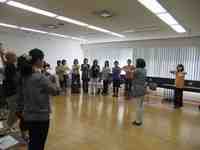 With Practice Key 1, we practiced the Basic steps of the MAT METHOD. Later, each attendee took turns and had a chance to experience how to teach within their smaller groups. We believe it is very important to follow these basic steps in order to enable the students to use the language to express what they really want to say later on. Also, it is important to teach extra vocabulary and the negative form to get students to personalize the expressions and say what they can do and cannot do. Using gestures and the special way of showing the picture cards can make this process fun and effective.
With Practice Key 1, we practiced the Basic steps of the MAT METHOD. Later, each attendee took turns and had a chance to experience how to teach within their smaller groups. We believe it is very important to follow these basic steps in order to enable the students to use the language to express what they really want to say later on. Also, it is important to teach extra vocabulary and the negative form to get students to personalize the expressions and say what they can do and cannot do. Using gestures and the special way of showing the picture cards can make this process fun and effective.
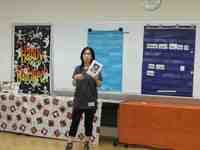 With Practice Key 2, we introduced how to change the subject to he/she. Many students have problems with pronouns when they are first taught in junior high schools, because they are not used to the concept of using pronouns. Pronouns are not usually used in the Japanese language. Teaching he/she with “can” is the easiest way for the students to understand this concept without the additional burden of changing the verb to “s”, such as in a sentence like, “He wants a cat.” The students can concentrate on the pronouns. With the MAT METHOD, we can teach in a fun way and build up grammatical competence at the same time.
With Practice Key 2, we introduced how to change the subject to he/she. Many students have problems with pronouns when they are first taught in junior high schools, because they are not used to the concept of using pronouns. Pronouns are not usually used in the Japanese language. Teaching he/she with “can” is the easiest way for the students to understand this concept without the additional burden of changing the verb to “s”, such as in a sentence like, “He wants a cat.” The students can concentrate on the pronouns. With the MAT METHOD, we can teach in a fun way and build up grammatical competence at the same time.
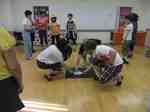 We introduced some other ideas to expand as we reviewed this sentence pattern. “How many times can you bounce a ball?” Using sentences like this, you can combine numbers and the “can” sentence. Can you think of the reason why “Noriko can’t cook curry.” The students can try to make longer sentences and use their imagination. Please try to give a little bit of challenge to your upper grader students and most likely you will see their eyes shining.
We introduced some other ideas to expand as we reviewed this sentence pattern. “How many times can you bounce a ball?” Using sentences like this, you can combine numbers and the “can” sentence. Can you think of the reason why “Noriko can’t cook curry.” The students can try to make longer sentences and use their imagination. Please try to give a little bit of challenge to your upper grader students and most likely you will see their eyes shining.
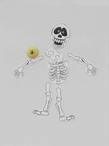 In the latter part of the meeting, we had fun doing Halloween activities and making an easy craft. In one game, each group had to gather bone parts to make a whole skeleton. In another game, two players had to cooperate and carry a white ghost (made with a white balloon) by holding it between their legs, arms or heads. The idea of making a pop-up hand with a paper cup and a disposable plastic glove caused a great sensation. Afterwards, we played another game and tried to collect as many candy rings as possible by putting the “ring” through the fingers.
In the latter part of the meeting, we had fun doing Halloween activities and making an easy craft. In one game, each group had to gather bone parts to make a whole skeleton. In another game, two players had to cooperate and carry a white ghost (made with a white balloon) by holding it between their legs, arms or heads. The idea of making a pop-up hand with a paper cup and a disposable plastic glove caused a great sensation. Afterwards, we played another game and tried to collect as many candy rings as possible by putting the “ring” through the fingers. 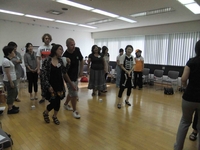
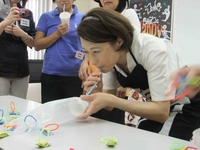
We ended the meeting telling the story, “What is in the Witch’s Kitchen?” This is a fun story for Halloween and also great for teaching “left” and “right”.
Please have a fun-filled Halloween with your students!! We hope that the skills and the ideas we shared will help you and your students to enjoy the lesson.
Happy Halloween and see you again at our next meeting on December 2nd!!!